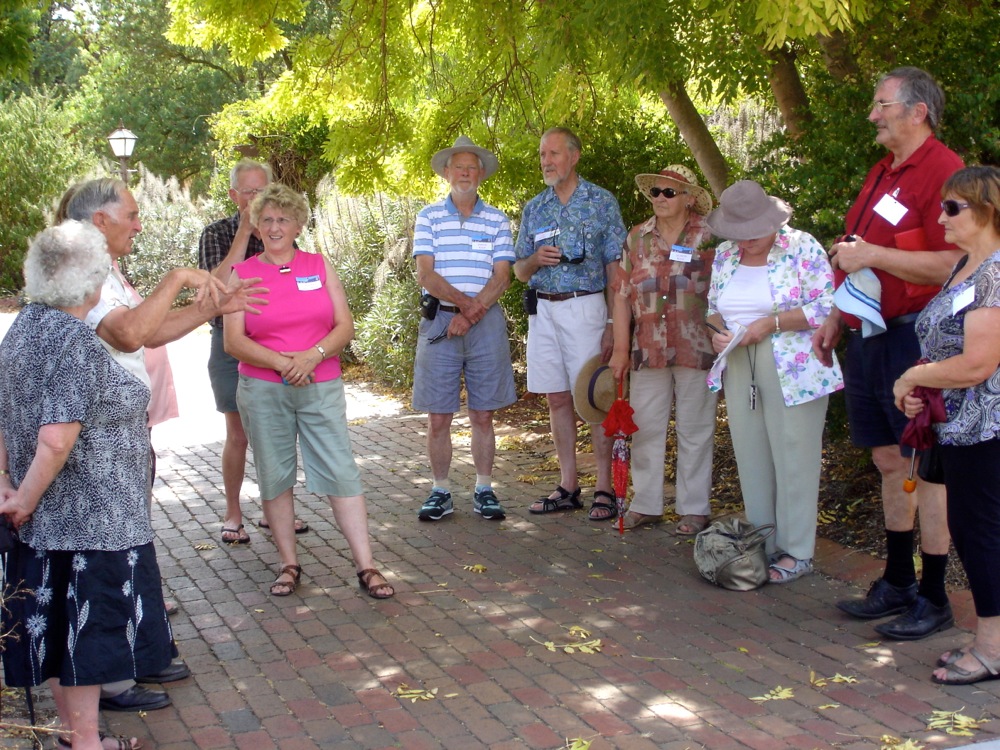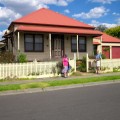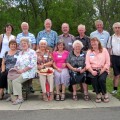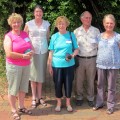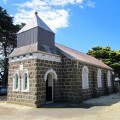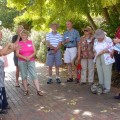Labour Day Weekend Tour
by John Noack / Joan WinterThe Grovedale and Freshwater Creek Tour, 9-10 March 2013
The Annual Tour of the Wendish Heritage Society to Grovedale and Freshwater Creek on 9-10 March 2013 was organized by June Winter and her family. Although the weather was hotter than is usual for the Autumn month of March, informative talks, refreshments and meals took place in the comfort of indoor venues. As usual, publicity was given to the important work of the Lutheran Archives in Adelaide and of the Friends of the Lutheran Archives in relation to the preservation of valuable historical, heritage items here in Australia. This was highlighted by the presence of Archivist Lyall Kupke on this Tour.
Grovedale, formerly Germantown
On Saturday 9 March, June informed us that Grovedale was formerly called “Germantown”, which had reflected the original settlement of this area by Europeans mainly from Prussia in the early 1850s. However, World War 1 gave rise to anti-Germanic sentiments and alternative names such as Churchill, Cornwall or Marlborough were suggested. In July 1915, the local Council chose the name “Grovedale”, which was already the name of a local homestead built earlier in 1847 by Mr Alexander Pennell. This home was later purchased by August Hartwich in the 1880s.
She explained that the ten original Prussian families had arrived on the ship “Emmy” in December 1849 as “vine-dressers”. They were subsidised by Dr Alexander Thompson, who was then living at his Kardinia Homestead in present-day Belmont. These settlers included both individual immigrants such as G. Finster, E.A. Henke, O Hanashke, F.W. Koch R Koch, W. Scheimeister, and the immigrating families of F.G. Boehm, J.C. Francke, Samuel Gerlach, W. Janke, J.G. Knatsch, F. J.G. Limme, Joseph Nicolai, W. Wagner, W. Wensel, J.G. Winter. Most of the Winters were buried in the Germantown Cemetery.
We were also informed that some arrived on the “Emmy” without assisted passages, including S. Andrieske, F. Baensch, G. Einsporn, J.G. Hermann, J.C.S Bieske, S. Kaeger, H. Paulke and S. Roehr. Most of these were buried at Germantown , often with the inscription “Hier ruhet in Gott”, which means “resting here in God”.
These Prussian Pioneers soon moved onto properties one acre in size located near the Chain of Ponds Creek. In 1854, they built their mud-walled and grass-roofed church on the Cemetery land in Church Street donated by Samuel Roehr. The first service on 24 June 1854 was conducted by Pastor Matthias Goethe, who served this congregation from Melbourne. In 1855, a manse was erected on Torquay Road near the corner of Perrett Street for Pastor J. G. Hausmann from Queensland and the Trinity congregation erected and dedicated the new stone church on 26 December 1859. When Pastor Hausmann resigned in 1861, Pastor Peter Jacobsen continued as the Pastor from 1861 to 1877, followed by Pastor J Bode in 1882. This congregation closed in 1949.
Also in about 1861, Pastor Herman Herlitz, who had a Jewish background and was trained at Basel, was called. When he arrived, legal issues arose and church services were continued at the Trinity Church located in the Cemetery. Mulholland’s “Bayview Hotel” next to the church was then purchased in 1865 as the manse and on 26 March 1871, St Paul’s Lutheran Church was dedicated by the recently installed Pastor George Heyer. He served until 1920 and today St Paul’s is still open to and welcomes innovation.
The Trinity Church at the Cemetery was also used as their school, with Mr Stanger as the Teacher from 1854 to 1858. Robert Renzow was the next Teacher, as well as the organist, treasurer and trustee of St Paul’s Lutheran Church. In 1868, a new School No. 283 was erected on land in Bailey Street donated by Robert Renzow.
After the land was cleared, vineyards were established. Unfortunately, the disease phylloxera invaded the area in 1875 and the vines were removed and replaced by orchards and market gardens.
Some descendant have remained in this area of Victoria, including members of the Baensch, Bieske, Klemke, Rossack, Grossman, Schultze, Winter and other families. They have been joined by further European settlers such as the refugees who had to leave their homes as a result of the occupations and the devastation experienced during the Second World War.
The afternoon Tour included a visit to some important heritage sites, including Cobbin Farm with its well-kept garden, storage shed and chapel and the Grovedale Public Cemetery, with the graves of pioneering settlers. Our evening dinner at a nearby country hotel completed a very informative day.
Waldkirch or St Davids at Freshwater Creek
On Sunday, our activities included a church service conducted at St Paul’s Lutheran Church in Grovedale and then a visit to Freshwater Creek. June Winter informed us that further Prussian and Silesian families arrived in Australia and in 1858, they selected and purchased land in this area. Clearing the land also involved cutting and carting wood.
Their wattle and daub church called “Waldkirch”, meaning “church in the woods”, was dedicated on 9 Oct 1859 by Pastor C Schurmann of Hochkirch, now Tarrington. The present bluestone church in the style of “Romanesque Revival” and designed by R. S. Tufts, was completed in 1868. The Bible brought to Australia by Johann F. Seiffert was used for the services
A letter from the National Trust on 13 Oct 1990 indicates that St David’s Lutheran church, Freshwater Creek has been Classified in the Register” as an important “component of the nation’s heritage”.
The Grovedale Rotary Club organized a suitable memorial for this early settlement and on 2 Nov 2008, a memorial stone and a sealed capsule were dedicated by Pastor Rolph Lungwitz. Dignitaries in attendance included local member Darren Cheeseman M.H.R and Cr Keith Grossman. June Winter presented some “Waldkirch” history and Pastor Theo Harms extended greetings and mentioned that he and his ancestors had conducted services here.
The inspection of the Cemetery next to the church revealed many early pioneering settlers, whose names are listed on a display board in the church’s vestry. The congregation’s interesting Cemetery Tour Guide includes biographical information about members of such early families as Baensch, Darsow, Grossman, Imer, Kubeil, Kurzmann, Leibhardt, Plier, Schmidt and Seiffert. Copies of both this list and this guide are now in the Library of the Wendish Heritage Society in Melbourne.
The church also contains memories, memorials and reminders of the heritage of the past in the donations of church-related items. These presentations connect the Bible, candleholders and the cross with the Baensches, the lectern and organ cabinet with the Raus, the font with the Kurzmanns, pews with the Paulkes, the altar with the Menzels and a framed calligraphy with the Winters.
A hearty mid-day meal and afternoon tea in the shade of the church prepared by local members of St David’s, as well as the tours of the church building and the adjacent Cemetery were much appreciated.
The above two locations played important roles in the Pioneering History of Victoria, during which the early settlers had to continue their lives in their new country with only what they were able to carry with them. Erecting a home, clearing the land, producing food and clothing, organizing transport and many other such tasks confronted them. They persevered and our Tour has reminded the participants that later generations, including the descendants, need always to recall and be grateful for the lasting contributions made by these industrious and far-sighted Australian Pioneers.
Photos by John Noack and Clay Kruger







